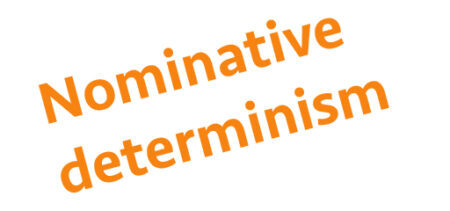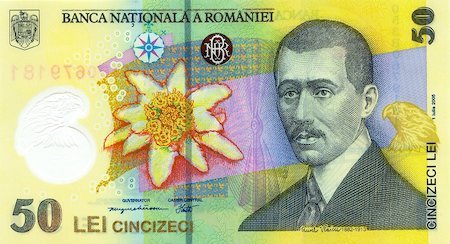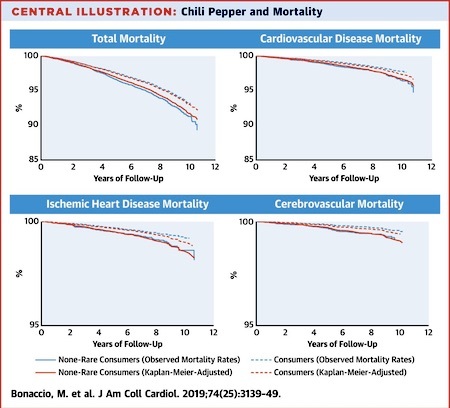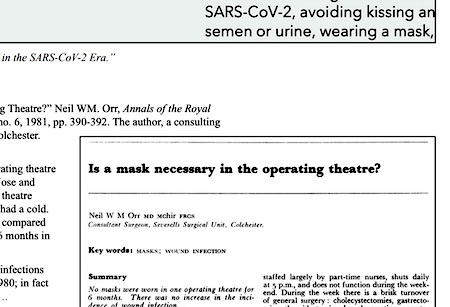Marc Abrahams's Blog, page 111
July 18, 2020
Pocket-Sized #1023: “Frozen Shirt of a Stranger”
Frozen Shirt of a Stranger
In this Pocket-Sized episode #1023, Marc Abrahams shows an unfamiliar research study to Jean Berko Gleason. Dramatic readings and reactions ensue.
The research mentioned in this episode is featured in the special Psychology issue (vol. 26, #1) of the Annals of Improbable Research magazine.

Remember, our Patreon donors, on most levels, get access to each podcast episode before it is made public.
1. Jean Berko Gleason encounters:
“Olfactory cues from romantic partners and strangers influence women’s responses to stress,” Marlise K. Hofer, Hanne K. Collins, Ashley V. Whillans, and Frances S. Chen, Journal of Personality and Social Psychology, vol 114, no. 1, Jan 2018, pp. 1-9.
Seth Gliksman, Production Assistant
Available on Spotify, Apple Podcasts, Overcast, Google Podcasts, AntennaPod, BeyondPod and elsewhere!

July 17, 2020
Nominative Determinism in the Medical World
 Mari Stoddard maintains a list of examples, from the medical world, of nominative determinism. “Nominative determinism” is the intentionally inflated name for a common phenomenon: some people work at professions that harmonize with their family name. Examples from the Stoddard list are these three doctors in the field of Emergency Medicine:
Mari Stoddard maintains a list of examples, from the medical world, of nominative determinism. “Nominative determinism” is the intentionally inflated name for a common phenomenon: some people work at professions that harmonize with their family name. Examples from the Stoddard list are these three doctors in the field of Emergency Medicine:
Dr Pulse, Dr Borer; Dr Cure, Dr Gore
(Thanks to Rick Vetter for bringing the Stoddard list to our attention.)
The phrase “nominative determinism” comes from our old friend and collaborator John Hoyland, who created and for decades wrote the “Feedback” column in New Scientist magazine. When John died, a few years ago, we published this: “Sad news: John Hoyland, father of “nominative determinism”, is gone“.

July 15, 2020
Pocket-Sized #1022: “Ice Cream & Term Paper Doug”
Ice Cream & Term Paper Doug
In this special Pocked-Sized episode #1022, Marc Abrahams extracts some some flash-frozen bits of history from techno-sociologist Gus Rancatore, proprietor of Toscanini’s Ice Cream.
Today, Gus shares with us the legend of Term Paper Doug.
Remember, our Patreon donors, on most levels, get access to each podcast episode before it is made public.
Seth Gliksman, Production Assistant
Available on Spotify, Apple Podcasts, Overcast, Google Podcasts, AntennaPod, BeyondPod and elsewhere!

July 13, 2020
Officials shut down source of dirty, prize-winningly dirty money
A notedly bacteria-friendly currency was targeted by counterfeiters who themselves were targeted by Romanian government officials. “Romanian officials shut down largest counterfeiter of polymer notes” trumpets a headline in Coin World, on July 13, 2020. The report goes on to say:
“Romania’s Directorate for Combating Organized Crime and Terrorism (DIICOT) released the news… Raids on five homes in Bucharest and nearby Busteni resulted in the arrest of three suspects. The counterfeiting group began operations in Spring 2014. Since then it made and passed over 17,000 100-lei bank notes, each equal to $23.17. DIICOT said in a statement, “In a relatively short time, the group’s leader managed to produce the best counterfeits in Romania’s history and become the biggest forger of plastic banknotes in the world.”
Prize-winning dirty money
The 1999 Ig Nobel Prize for economics was awarded to Habip Gedik, Timothy A. Voss, and Andreas Voss, for testing which country’s paper money is best at transmitting dangerous bacteria.
They documented their research, in the study “Money and Transmission of Bacteria,” Habip Gedik, Timothy A. Voss, and Andreas Voss, Antimicrobial Resistance and Infection Control, vol. 2, no. 2, 2013. The study says:
“Our experiments showed that the polymer structure of the Romanian Leu banknote allows growth and transmission of multi-drug resistant pathogens. This, in theory, could contribute to the transmission of microorganisms within the Romanian community. Countries using polymer-based banknotes should take this into consideration…”

“Humans smell in stereo” [new study]
Can we smell in ‘stereo’? Recent experiments performed at the University of Chinese Academy of Sciences in Beijing suggest that, to some extent, in some circumstances, the answer could be ‘yes’ – and, moreover, this stereo sense may be a navigational aid. The research team write that :
“The human nose, the most protruding part of the face, bears two nostrils that are separated by the nasal septum and inspire air from nonoverlapping regions (roughly 3.5 cm apart) in space. Theoretically, this provides a computational advantage to localize odor sources as compared with sampling at one point in space.”
With the help of participants using the apparatus shown in the diagram, which dispensed various concentrations of phenylethyl alcohol (a rose-like odorant) and vanillin (a vanilla-like odorant), the experimenters were able to determine that :
“
[…] a moderate binaral intensity disparity produces a subliminal directional cue that reliably modulates the perception of self-motion independent of trigeminal activity or nasal cycle. Put differently, humans smell in stereo and utilize olfactory stereo cues in the determination of heading direction, despite that they are not verbally aware of such cues.”
Furthermore :
“[…] a moderate internostril difference in odor intensity consistently biases recipients’ perceived direction of self-motion toward the higher-concentration side, despite that they cannot report which nostril smells a stronger odor. The findings indicate that humans have a stereo sense of smell that subconsciously guides navigation.”
See: Humans navigate with stereo olfaction PNAS, June 22nd, 2020,
[ Research research by Martin Gardiner ]

July 11, 2020
Pocket-Sized #1021: “Rain Run Walk”
Rain Run Walk
In this Pocket-Sized episode #1021, Marc Abrahams shows an unfamiliar research study to Chris Cotsapas. Dramatic readings and reactions ensue.
The research mentioned in this episode is featured in the Important Research issue (Vol. 25, #5) of the Annals of Improbable Research Magazine.

Remember, our Patreon donors, on most levels, get access to each podcast episode before it is made public.
1. Chris Cotsapas encounters:
“How Wet Do You Get in The Rain, If You Don’t Care How Wet You Get?” T.C. Lipscombe, Journal of the Washington Academy of Sciences, Fall 2017, pp. 1-15.
Seth Gliksman, Production Assistant
Available on Spotify, Apple Podcasts, Overcast, Google Podcasts, AntennaPod, BeyondPod and elsewhere!

July 10, 2020
Chili Pepper Consumption and Mortality in Italian Adults
In the wake of the Ig Nobel Prize-winning studies about whether eating Italian pizza in Italy might lengthen life, comes a new study about Italians who eat chili peppers:
“Chili Pepper Consumption and Mortality in Italian Adults,” Marialaura Bonaccio, Augusto Di Castelnuovo, Simona Costanzo, Emilia Ruggiero, Amalia De Curtis, Mariarosaria Persichillo, Claudio Tabolacci, Francesco Facchiano, Chiara Cerletti, Maria Benedetta Donati, Giovanni de Gaetano, Licia Iacoviello and on behalf of the Moli-sani Study Investigators, Journal of the American College of Cardiology, vol. 74, no. 25, December 2019.
The authors explain:
This study sought to examine the association between chili pepper consumption and risk of death in a large sample of the adult Italian general population, and to account for biological mediators of the association.
Conclusions In a large adult Mediterranean population, regular consumption of chili pepper is associated with a lower risk of total and CVD [cardiovascular disease] death independent of CVD risk factors or adherence to a Mediterranean diet. Known biomarkers of CVD risk only marginally mediate the association of chili pepper intake with mortality.
(Thanks to Thomas Michel for bringing this to our attention.)

July 9, 2020
Ice Cream Stick Production Tradeoff
Tradeoffs vex the production of even the most pleasure-producing products, such as ice-cream-on-a-stick treats. This study studies some of those tradeoffs:
“,” Riswanti Sigalingging and Lukman Adlin Harahap, Researchers World, vol. 2, no. 3, 2011.
The authors, at the University of North Sumatra, Indonesia, report: “Base cost can be reduced by using less expensive ice cream ingridients [sic] but it will increase the amount of ice cream stick to be produced and sold…”
Also
And don’t forget the Nutty ice cream stick patent, and the investigation of ice cream sticks’ aroma influence.

July 8, 2020
Pocket-Sized #1020: “Spin-Stretched Ant Neck”
Spin-Stretched Ant Neck
In this Pocket-Sized episode #1020, Marc Abrahams shows an unfamiliar research study to Melissa Franklin. Dramatic readings and reactions ensue.
The research mentioned in this episode is featured in the Centrifugal Research issue (Vol. 20, #3) of the Annals of Improbable Research Magazine.

Remember, our Patreon donors, on most levels, get access to each podcast episode before it is made public.
1. Melissa Franklin encounters:
“The Exoskeletal Structure and Tensile Loading Behavior of an Ant Neck Joint,” Vienny Nguyen, Blaine Lilly and Carlos Castro, Journal of Biomechanics, vol. 47, no. 2, January 22, 2014, pp. 497–504.
Seth Gliksman, Production Assistant
Available on Spotify, Apple Podcasts, Overcast, Google Podcasts, AntennaPod, BeyondPod and elsewhere!

July 7, 2020
Are masks necessary in operating rooms, in ordinary times?
Questions of masks and spittle, and separately—and startlingly—the question of whether masks are necessary in ordinary, non-pandemic times in hospital operating rooms. Four medical studies covering those topics get a good looking at in the “Wear a Mask?” column in the special Small Animals issue (vol. 26, no 3) of the Annals of Improbable Research.

Marc Abrahams's Blog
- Marc Abrahams's profile
- 14 followers






